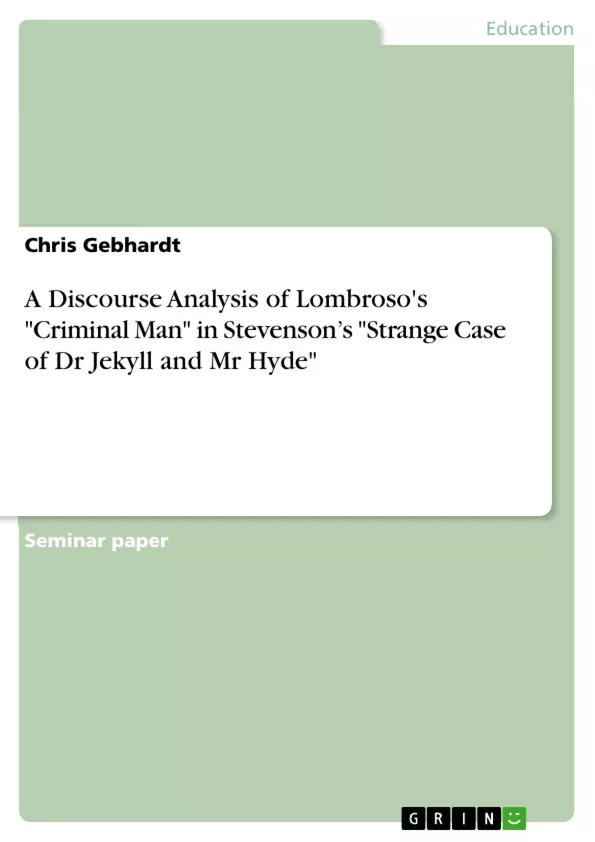The gothic romance Strange Case of Dr Jekyll and Mr Hyde (1886) by Robert Louis Stevenson is a great example to show how the fear of degeneration could be portrayed in literature and how these signs could be examined by means of the new developed sciences. Therefore, this seminar paper will focus on a discourse analysis as critical approach in terms of Michel Foucault, to show how the discourses of criminal anthropology and evolutional biology are captured in the novel, in which contexts they are embedded and which functions they could serve.
Inhaltsverzeichnis (Table of Contents)
- Introduction
- Degeneration, Atavism and Lombroso's Criminal Man
- Edward Hyde and the Criminal Man
- Atavism and Criminality
- Diseases Creating the Criminal Man
- The Environment of the Criminal Man
- Defining the Source of Victorian Fear
- Conclusion
Zielsetzung und Themenschwerpunkte (Objectives and Key Themes)
This seminar paper aims to conduct a discourse analysis of Robert Louis Stevenson's Strange Case of Dr Jekyll and Mr Hyde, using the critical approach of Michel Foucault, to reveal how the discourses of criminal anthropology and evolutionary biology are embedded within the narrative and the functions they serve. It explores the similarities between Cesare Lombroso's concept of the "Criminal Man" and the character of Edward Hyde, examining how the novel attempts to classify the unknown through the lens of these scientific theories.
- The Victorian fear of degeneration and its impact on society and literature
- The emergence of criminal anthropology as a scientific field and its influence on Victorian thought
- The relationship between atavism, criminality, and the physical characteristics of the “Criminal Man”
- The portrayal of Edward Hyde as a manifestation of the "Criminal Man" in Stevenson's novel
- The use of the human body as a text in the novel, with signs and signifiers of degeneration
Zusammenfassung der Kapitel (Chapter Summaries)
The introduction provides historical context for the Victorian anxieties surrounding degeneration and the rise of new scientific disciplines. It highlights the influence of Darwin's theories and the fear of atavism, setting the stage for the analysis of Stevenson's novel.
Chapter 2 delves into the concept of degeneration, exploring the theories of Morel, Lankester, and the role of atavism in these debates. It introduces Cesare Lombroso and his groundbreaking work in criminal anthropology, which seeks to define the physical and psychological characteristics of the "Criminal Man."
Chapter 3 focuses on the application of Lombroso's theories to Stevenson's Strange Case of Dr Jekyll and Mr Hyde, highlighting the similarities between the "Criminal Man" and Edward Hyde. It examines how the novel utilizes physical descriptions and characterization to present Hyde as a manifestation of atavism and criminality.
Schlüsselwörter (Keywords)
The primary keywords and focus topics of this seminar paper are: Victorian literature, criminal anthropology, degeneration, atavism, Cesare Lombroso, "Criminal Man," Robert Louis Stevenson, Strange Case of Dr Jekyll and Mr Hyde, Edward Hyde, discourse analysis, Michel Foucault, human body as text, and signifiers of degeneration.
- Quote paper
- Chris Gebhardt (Author), 2014, A Discourse Analysis of Lombroso's "Criminal Man" in Stevenson’s "Strange Case of Dr Jekyll and Mr Hyde", Munich, GRIN Verlag, https://www.grin.com/document/271917



